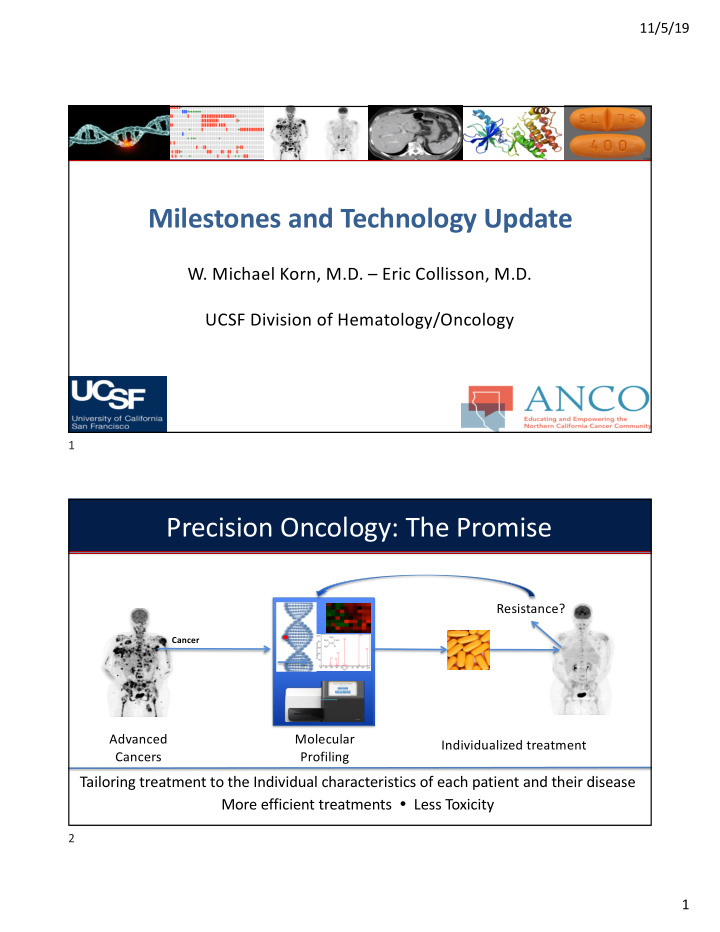



11/5/19 Milestones and Technology Update W. Michael Korn, M.D. – Eric Collisson, M.D. UCSF Division of Hematology/Oncology 1 Precision Oncology: The Promise Resistance? Cancer Advanced Molecular Individualized treatment Cancers Profiling Tailoring treatment to the Individual characteristics of each patient and their disease More efficient treatments Less Toxicity 2 1
11/5/19 Precision Oncology: Growing Complexity 3 Precision Oncology: Challenges De-novo and acquired Complex, disease-specific Resistance mutational landscapes On-target Off-target Molecularly Tumor heterogeneity Driven Micro-environment Therapies Microbiome Drug development 1,000 drugs in development for cancer indications 4 2
11/5/19 Rare Fusion Genes with High Impact 5 5 NTRK Fusions occur all over the body 6 3
11/5/19 Responses to the TRK inhibitor Larotrectinib Lassen et al., ESMO 2018 7 7 FDA Approval of Larotrectinib (Vitrakvi) 8 4
11/5/19 NRG1 Fusions: Constitutive Activation of HER3 Signaling Fusions preserve EGF-like domain of NRG1 and transmembrane domain of fusion partner Measurable response after 16 weeks of apatinib treatment in patient with NRG1-fusions positive cholangiocarcinoma and hepatic metastases Jones et al., 2017 Dimou and Carmidge, Clin. Cancer Res., 2019 9 10 5
11/5/19 NTRK Resistance Mutations 11 Detection of Clonal Dynamics by Cell-free DNA 63 y.o woman with metastatic sigmoid colon cancer, initially KRAS WT Strickler et al., Cancer Discov., 2018 12 12 6
11/5/19 Gene Fusion Detection: RNA superior to DNA Problem: some introns too long (NTRK3) or not tilable • 14% (36/254) fusions detected by RNAseq that were missed by MSK-IMPACT. • 48% gene fusions identified exclusively by RNAseq would have been expected to be detected by the MSK-IMPACT panel based on its design. Benayed. et al, Clin. Cancer Res., 2019 13 Whole Transcriptome RNA Sequencing Provides Diverse Analytical Insights Gene regulation Fusion Detection mRNA Variant Detection 14 7
11/5/19 Low Frequency Mutations Share Common Themes Colorectal Cancer (MSS) S Chromatin- Oncogenic DNA Repair remodeling Signaling D S C S D S D D SS S DD C S S D D S D S D S S S S D 15 Tumor Mutational Burden explains 55% of variability in response to immune checkpoint inhibition Yarchoan et al., NEJM 2017 16 8
11/5/19 Disease-Specific Distribution of TMB Predicts Sensitivity to Immune-checkpoint Inhibition Samstein et al., 2019 17 PolE mutations: Taking TMB to the extreme • A 39 y/o man presented to UCSF GI Oncology with extensively metastatic colon cancer and PD on conventional chemotherapy. • Patient in poor performance status, referred to hospice. • Next-generation DNA sequencing revealed a pathogenic PolE P286R mutation as well as a large number of additional mutations. 18 9
11/5/19 Prolonged response to immunotherapy • Single agent anti-PD-L1 therapy with pembrolizumab was initiated in December 2016. July 2018 October 2016 • Treatment ongoing, patient active and in good performance status. Courtesy Dr. van Loon, UCSF 19 Colorectal Cancer: Precision Oncology Roadmap 20 10
11/5/19 21 Next Generation Profiling (NGP): Discovery of Clinically Relevant Signatures through Machine Learning NGS (DNA Alterations) Matched DEAN • Single Variants • Insertions/Deletions Clinical (Cognitive Computing) • Tumor Mutational Burden Outcome • Support Vector + IHC (Protein Expression) Data Machine • Random Forest • Logistic Regression RNA (Gene Expression) (19,600+ • Neural Networks patients and • Naïve Bayes ISH (DNA Copies) growing) • Quadratic • Gene Copies Discriminant Analysis • Gene Translocations • KNN Abraham et al., Caris Life Sciences, unpublished 22 11
11/5/19 An Assembly of Mathematical Models Coupled With Neural Networks Algorithm 1 Algorithm 113 Algorithm 12 Algorithm 140 Algorithm 33 Algorithm 215 Algorithm 45 Algorithm 231 Algorithm 50 Algorithm 301 Algorithm 56 Algorithm 312 YES 23 NGP FOLFOX Predictor Patient Characteristics (Testing Dataset) Characteristic Benefit No Benefit p N=103 (%) N=61 (%) Median Age 58 59 0.250 Female/Male 44/56 49/51 0.603 Colon/Rectal 93/7 77/23 0.003 Left/Right/unknown 35/42/23 51/38/11 0.069 Bevacizumab 100 100 1.000 Cetuximab 9 15 0.351 Abraham et al., Caris Life Sciences, unpublished 24 12
11/5/19 Clinical validation using an independent cohort of patients who received FOLFOX in 1 st line FOLFOX-NGP TRIBE-2 Median TTNT (mo) Benefit: 11.9 Non-Benefit: 7.6 Abraham et al., Caris Life Sciences, unpublished Cremolini et al., ASCO 2019 25 FOLFOX Predictor Not Predictive of Response to First-Line FOLFIRI Abraham et al., Caris Life Sciences, unpublished 26 13
11/5/19 The Future of Precision Oncology Improved Access to Molecular Profiling Earlier Testing: IO Predictors, Gene Fusions etc. Next generation DNA sequencing Copy Number Improved RNA expression / Gene fusion Proteomics Real-World Clinical analysis Outcomes Data Outcomes Proteomics Liquid biopsy Clinical Outcomes Better Drug Access Individualized Basket Trials (FDA, Basket Trials, Reporting Drug Combinations) Distributed Trials Machine Learning (Just-in-Time) 27 Acknowledgement Medical Affairs Division of Hematology/Oncology Eric Collisson Todd Maney Katherine van Loon Rebeca Feldman University of Pisa Joanne Xiu Chiara Cremolini HDFCCC Alan Ashworth R & D David Spetzler Cortney Flookes James Abraham University of Southern California Jose L. Gonzales Heinz-Joseph Lenz Dan Magee Mark Miglarese 28 14
11/5/19 Thank You! michael.korn@ucsf.edu wmkorn@carisls.com 29 15
Recommend
More recommend